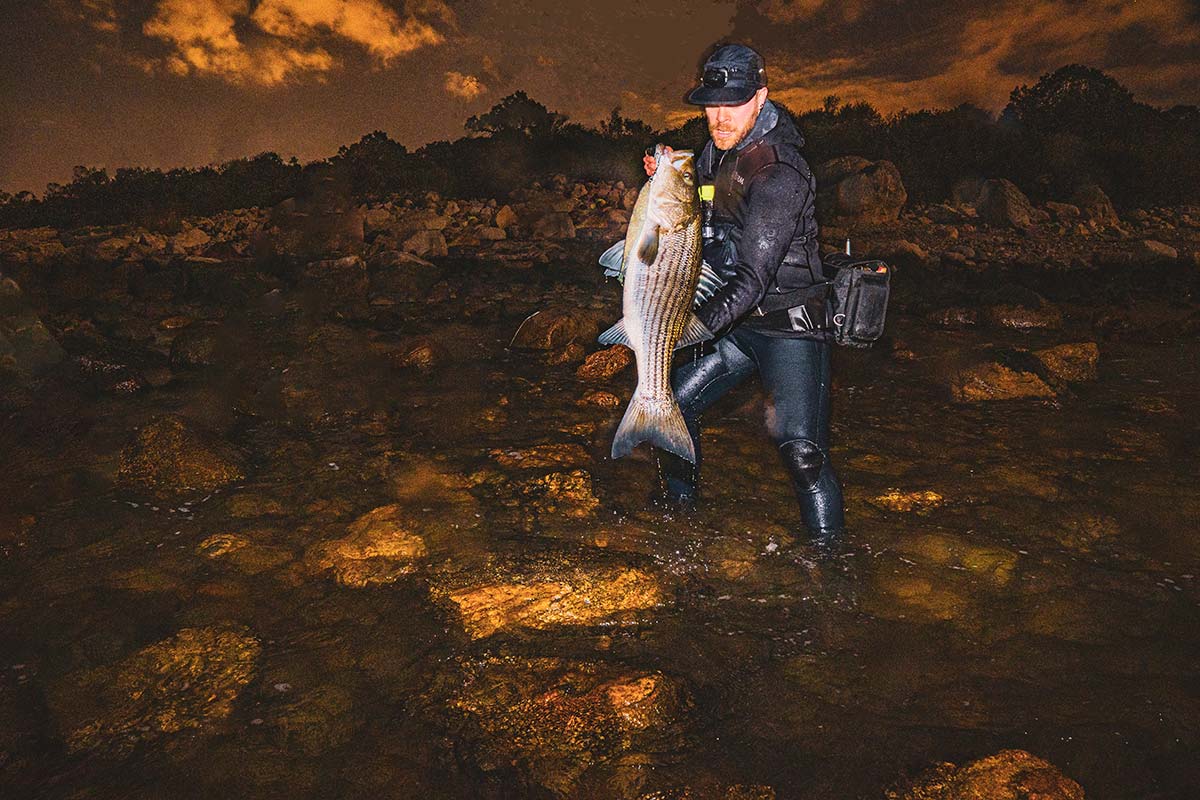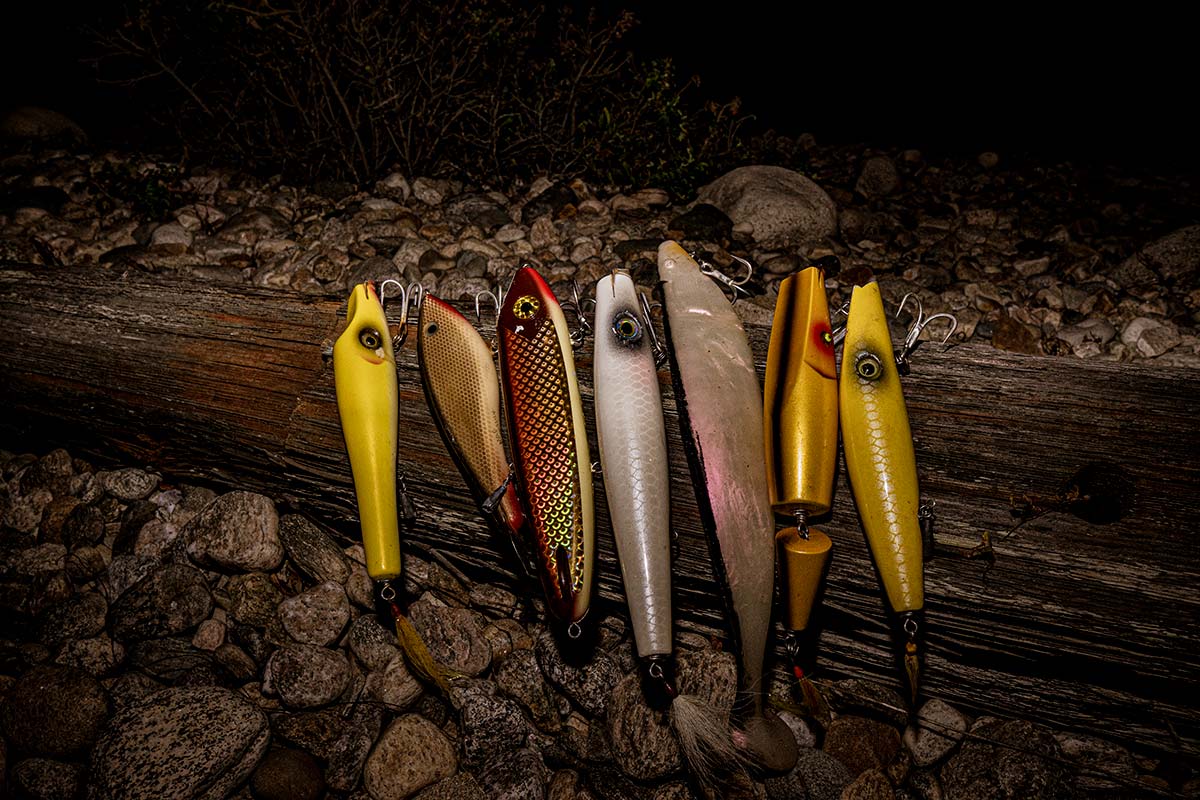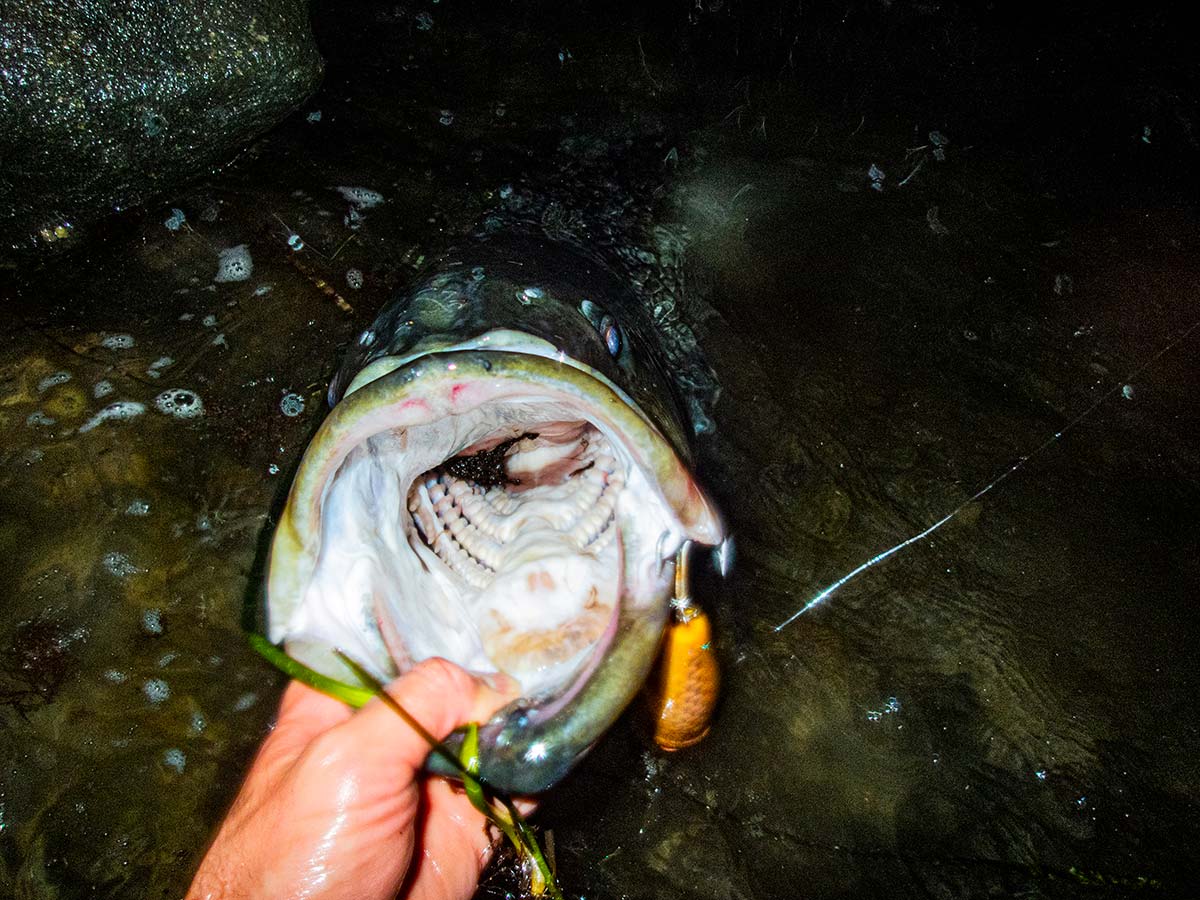
The fall run is in a spectrum of different stages right now in New England, depending on where you live. It could be virtually completely over, or you could be entering the final good tides of the season. However, for the most part most, the larger fish are gone and those that remain are smaller schoolies and resident fish that will stay the winter. Yet, every year in early November there are a few giant fish taken from the Canal, the surrounding Cape beaches, the Rhode Island breachways, and particular areas in Connecticut. In days-gone-by, it was the very best time of the fall on the Outer Cape. Even now, with the fishery diminished, these final late season fish can be some of the largest of the entire year, and I always treat the first moon of November as trophy time. I know the numbers of cows in my area is extremely low, but I also fully believe—totally, and without question—that there are still some absolute jumbos around the Cape, Buzzards Bay, and Rhode Island until at least Thanksgiving.
Case in point, every year for the last six years I’ve found really huge shad on some of the Cape beaches, and this always gets me excited that there has to be a few big fish that hang around to feed on this huge bait. Stripers love shad, and with water temperatures still in the 50’s, there’s no reason for them to hurry south. Four years ago, I had a moment that bordered on undeniable proof. I was fly fishing a hot sand eel bite on a sandy Cape beach, catching schoolie after schoolie, with a few 28- to 32-inch fish mixed-in. I was having a lot of fun when suddenly there was a couple gigantic splashes pretty close to shore, and in the quiet of the night, it just about scared me to death. I saw at the time what I thought were bunker jumping out of the water, fleeing what I assumed was probably seals. I flipped on my light, and saw some really big flashes, far too big for bunker, but my brain couldn’t reconcile what I was seeing. I continued to assume it was a couple of seals chasing bunker. However, perhaps 5 minutes later I caught several really big shad on my fly rod and realized it was probably big bass attacking the shad which were mixed-in with the schoolies. This got my heart pounding and my adrenaline up! I immediately put on the biggest fly I had, but had no hits for the remainder of that balmy November night. Ultimately, the fact I had no more hits was no surprise; my largest fly was perhaps 8 inches long, with a height of maybe 3 inches; larger than a Super Strike darter, but nowhere near as big as the shad I caught which were 15 inches long and probably pushing 6 inches deep. The profile my fly offered was just nothing even close to the size of these jumbo shad. I debated going back to the car to get my plugging gear, but I had nothing in my bag that would match the profile of the shad any better than the fly did.
That night was really what got me thinking about the premise that will constitute the rest of this article. While I have had the thought many times before, this night spurred the question mostly deeply for me: is it possible to have too big a lure for striped bass?
The Hypothetical
First, let’s consider a couple other species for a moment. Trophy largemouth bass fisherman use swim bait lures that exceed most typical striper plugs. Those anglers sling custom made 12-inch lures to fish that may only top out at 12 or 13 pounds, and the absolute monsters somewhere around 15 to 17 pounds. Now, I concede a 15-pound largemouth has an appetite that certainly matches a 15-pound striper, and a mouth that probably exceeds it, yet trophy striper fisherman are hunting for fish over 50 pounds! And a 15-pound striper is at least two to three times more powerful than a largemouth of the same size. Further, when we compare what the typical surf fisherman is using to the typical musky fisherman, the story is the same. Many musky lures exceed 15 inches, and I’ve seen several available for trolling that push beyond 20 inches and max out around 2 pounds! While it’s not exactly fair to extrapolate between species (giant 1000-pound tuna for example generally eat small prey), I think it is fair to say that all three of these species have a similar “eat whatever they can catch” mentality, and that their forage opportunities all include prey items that exceed 20 inches. Yet, freshwater anglers put us surf guys and gals to shame with their willingness to huck huge lures to their predators.

Which brings me to my next point: stripers have some very large forage available to them, all season long, and they have been documented repeatedly to have no aversion to attack it. I am a big believer in fishing boulder fields because these areas offer consistent feed all year which doesn’t move around a whole lot. Amongst the feed available to stripers in boulder fields, black sea bass and tautog are probably two of the larger species. These fish can get large themselves, and a 5-, 8-, or even 10-pound tog offers a tremendous calorie pay-off for a trophy-sized striper. I have personally seen a filleted near-40-pound striper with a partially digested black sea bass in its stomach which weighed almost 5 pounds on a scale. If a 40-pound striper is willing to attack a 5-pound sea bass, what would a 60-pound striper be willing to chase? Further, John Skinner tells a very compelling story in his book A Season on the Edge of a striper that attacked his eel, while having a dead and half-digested 5-pound-plus bluefish hanging out of its mouth! Finally, if you think big stripers don’t feed on the plethora of smaller schoolies we have, you are fooling yourself; I’ve heard rumors of fish as small at 25 pounds attacking 20-inch schoolies!
Finally, if you’ve been fishing the surf for any amount of time, you’ve probably encountered at least a schoolie or two that have attacked lures that are nearly the size of their own body. Personally, I’ve had plenty of 15- to 18-inch stripers hit 12-inch long needlefish, and caught a 20-inch schoolie this season on a 12-inch plastic shad. Stripers are aggressive, and particularly if they sense a prey item is injured, they are unafraid to take on a potential meal that constitutes a third or half of their body length or weight. Extrapolate that up to a 50-inch bass, and again it suggests we should be slinging lures in excess of 20 inches in the surf.
Therefore, when we consider that most of the lures we’re throwing in the surf are 3- to 8-inches long and weigh less than 4 ounces, I would argue that we as surf fisherman (and boat guys, too) are generally only offering small snacks and appetizers to trophy-sized bass.
Jumbo Plugs
I fully admit, this argument is partially hypothetical and in practice it can be hard to actualize on the theory. That is, finding 15- to 20-inche lures and then actually fishing them is very difficult. Trust me, I have been trying for a couple years now. First, they are hard to even find and purchase, second they are hard to carry in a traditional plug bag, third they are exhausting to cast over and over, and fourth casting a 12-ounce lure requires specialized gear that takes a lot of the joy out of fighting moderately-sized fish. However, I have a couple suggestions I personally use that are larger than most of the traditional surf plugs out there, if you’d like to try throwing some larger profiles.
First, I think that rubber plugs are the place to start if you’d like to try some giant lures. There are several options that are affordable in the 10- to 15-inch range designed for musky which are suitable for the surf. I have been having fun experimenting with Action Shads in 12- and 15-inch sizes for a couple of years now. They are relatively slim and easy to cast for 6- and 10-ounce plugs. I’ve been in a couple situations recently where the fish would only hit these giant lures, and they totally ignored all others. The moon was extremely bright, and I believe there were bunker in the current in front of me. While they could seemingly discern that the needles, darters, and metal lips were fake, the fish were absolutely slamming these big swim baits—every hit was jarring and savage! This tells me a lot, but specifically that the fish were completely convinced these giant rubber fish were the real thing. While I lost several fish over those two nights, I landed a few slot fish, a couple more 16- to 20-pounders, and one nicer fish in the low 30-pound class.
These rubber baits have the benefit of being unweighted, so you can fish them however you want whether by adding a jig head, using a giant 12/0 Owner Beast swim bait hook, or rigging them with a treble hook like musky fisherman often do. Being able to dial in the swimming depth—from right on the surface, to scraping the bottom—is a significant advantage of these giant swimmers, but also many rubber lures in general. However, if these are still a little too intimidating or hard to cast, the “rubber ducky” 9-inch Storm WildEye shads cast great and offer a relatively big profile at an affordable price. These baits all have the benefit of being deep bodied, so they give off a large visual and vibration profile in the water, but are not so heavy that they are impossible to cast.

Next, I think extremely long, skinny profiles are another great way to compromise between a large profile and castability. There are several makers that offer wood needle fish at 12 inches, but Hogy offers a 14-inch long eel-like soft plastic that dwarfs these offerings. While they’re thin, the length suggests a very large meal to any passing striper. Being soft-plastic and weight-less, you can set them up to fish exactly how you wish: deep on a jig head, or shallow on a swim bait hook. Unfortunately, Shankas is no longer in business, because their giant, 14-inch soft-plastic was even better, and a larger alternative to the 12-inch Lunker City Slug-Go. However, the 12-inch Slug-Go is still a relatively large profile that I think is highly underutilized. It offers a much larger profile then many other plastic swimmers and wood plugs you’ll find on tackle shop shelves.
Finally, I have a few niche wood and plastic lures that top out around 12 inches and are still fishable on general surf fishing gear. Mikes Custom Big Ben is considered one of the larger metal lips available out there at 10 inches (14 inches with flag) and is great plug that I carry on my trophy trips. I also recently acquired a Chris Voorhies troller which is about the same size, but fishes a lot deeper. Surf Asylum has recently started offering a similarly sized jumbo-deep swimmer at 10 inches as well. Tank Surfcasting also offers a very large affordable pikie which swims excellent and casts well. I also have been playing with a 10-inch, 10-ounce ERC Hellhound glide bait this season, and that is the largest glider I’ve yet to get my hands on. It’s gigantic and displaces a lot more water than its length would suggest. Finally, while I don’t fish much during the day, I’m really excited about the testing I’ve been doing of Surf Asylum’s (Dave Anderson) new prototype giant spook, which will be available this winter. It makes the Doc spook look like a kiddie toy, and while I’ve only hooked one fish with it at the time of writing, it was an absolute beast of a fish that bent the treble hook and stretched the split ring.
Gear And Conditions To Match
By now, you’re almost certainly thinking some version of the question, “But how do we cast these giant lures?” The answer is pretty simple: with very powerful gear, and on days and nights that allow it. First, I have actually found that once you start to get into rods rated to 8 ounces, many can usually handle slightly more than their ratings if you’re just lobbing the plug 50 yards. For example, I have a new Lamiglas Carbon Surf rod that is rated 3-8 ounces that will easily cast 10 ounces, and if needed, it’ll lob out 12 ounces without too much trouble. Most reputable brands offer rods that provide this same ability at the upper power ratings of their rods. But make no mistake, at least for me, once I start casting lures that are over about 8 ounces I get to the limit of what I consider a “normal” casting motion. I am not strong enough to really lean into a 10-ounce lure for 3 hours of straight casting. For this reason, you also have to consider your physical limit, and know that there is gear that is more powerful than your ability to cast it. I’ve owned 12- and 13-foot “chunking” rods, and they are incredibly strong and powerful. However, it’s much different casting huge plugs than when you’re bait fishing, and I suggest you steer clear of the extremely long, stiff, and powerful bait rods used by chunkers—these rods tend to be exhausting to cast repeatedly as those fishermen and women are generally only making a cast every 10 to 30 minutes. We lure fisherman have to make casts every minute or so! Also, I suggest using 50- to 65-pound braid when casting these plugs. I have found that if you make a slight mistake while casting, 30-pound braid cannot handle the extreme amount of inertia and force associated with casting very heavy plugs, and as such is prone to breaking.
The other factor to consider is only using giant plugs when the weather allows. I recently got back from a 6-day surf fishing bender in 15- to 40-knot winds and 5- to 15-foot seas. The entire trip I was limited to lures that I could cast in those conditions, and I never even considered tossing a giant metal lip or soft plastic. It doesn’t matter that these giant lures are heavy, they are not aerodynamic, which means the wind blows them right back in your face even on the hardest casts. Further, it’s hard enough work casting a 2-ounce bucktail in strong winds all night, I can’t imagine how sore I’d be trying to cast a 10-ounce glide bait! That being said, windy conditions where the wind is at your back can be the very best time to cast these giant plugs. The wind helps the plugs travel further, and also helps prevent fouling from spinning or tumbling which is often inevitable with these giant plugs. Identifying spots that fish well with a wind at your back is probably the number one tip I can give if you’d like to fish some of these giant lures.





